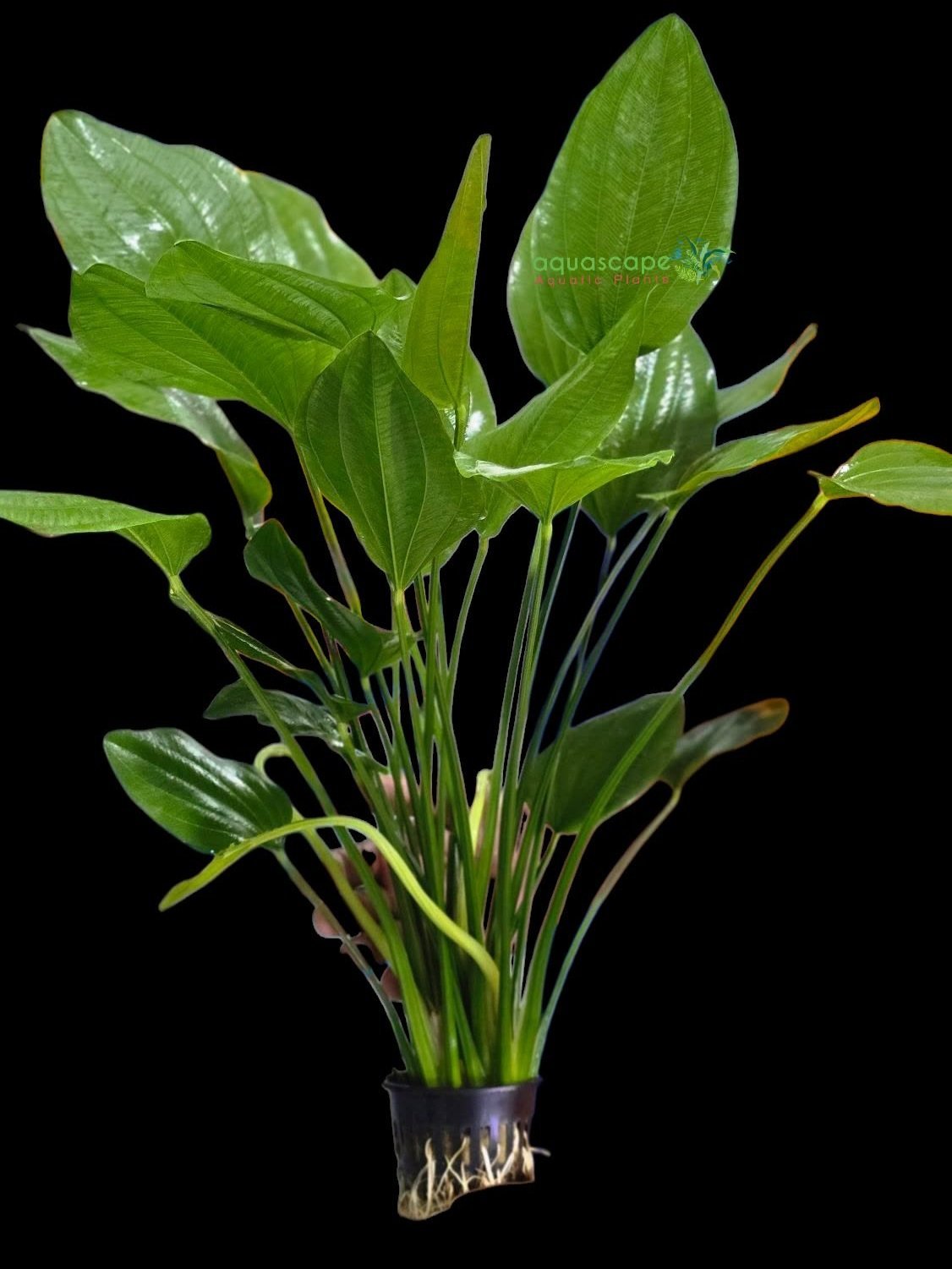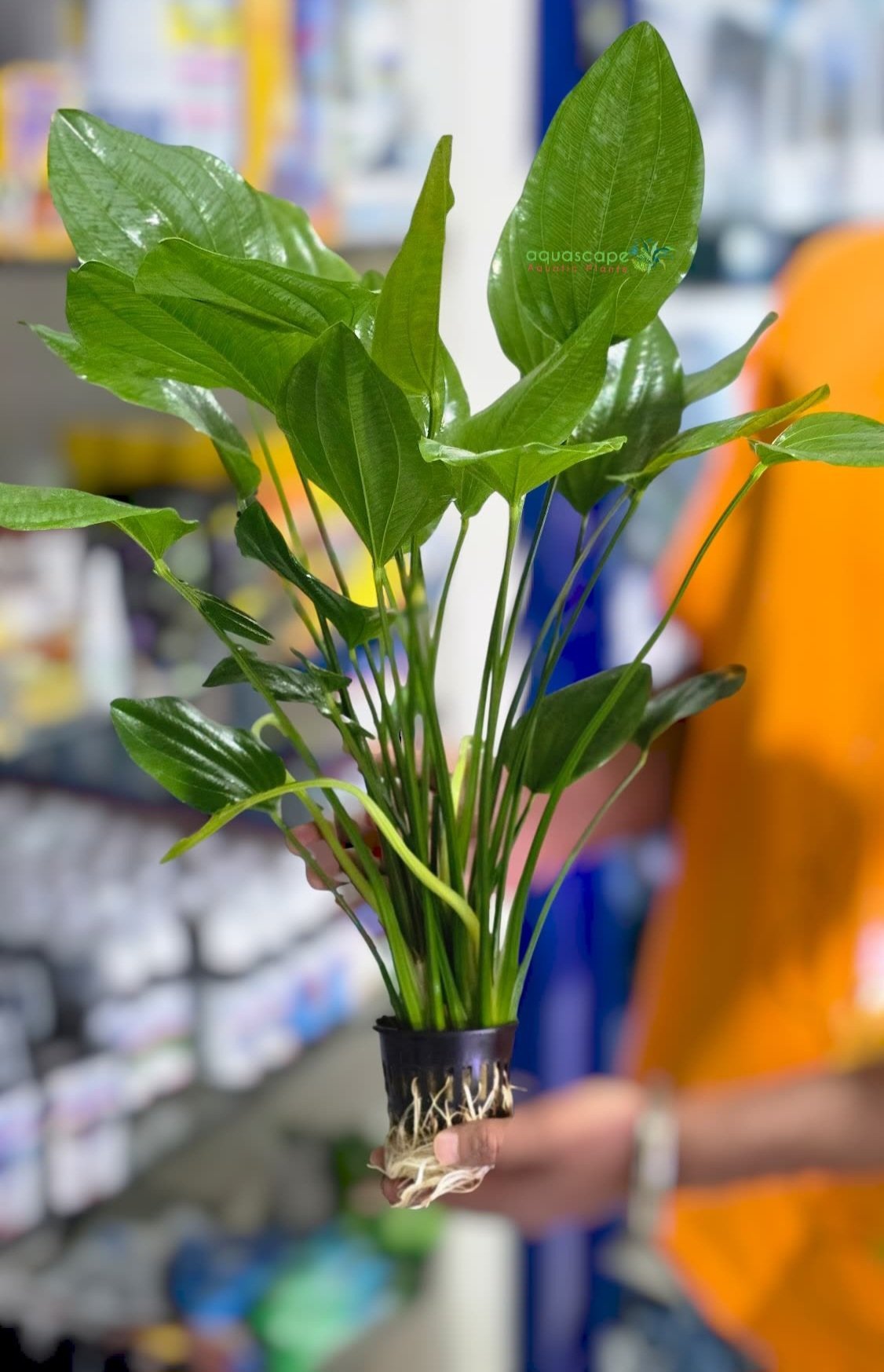Echinodorus argentinensis Mother Plant XXXL 80cm high
Echinodorus argentinensis is a species of aquatic plant in the Alismataceae family, native to South America (Argentina, Brazil, Paraguay, and Uruguay). It is a robust, semi-aquatic or aquatic plant often used in ponds and large aquariums due to its impressive size and attractive foliage.
Description:
-
Leaves: Broad, lanceolate to oval, with prominent veining. Mature leaves can grow up to 12-18 inches (30-45 cm) long.
-
Color: Bright to dark green, sometimes with a slightly wavy edge.
-
Growth Form: Rosette-forming, with long petioles (leaf stems) emerging from a central root crown.
-
Size: Can reach up to 20-24 inches (50-60 cm) in height when fully grown.
-
Flowers: Produces tall inflorescences with small white flowers when grown emersed (above water).
-
Root System: Strong, fibrous roots that anchor well in substrate.
Care Tips:
-
Lighting:
-
Moderate to high light is ideal for healthy growth.
-
Can tolerate lower light but may grow more slowly and produce smaller leaves.
-
-
Water Parameters:
-
Temperature: 68-82°F (20-28°C).
-
pH: 6.5-7.5 (slightly acidic to neutral preferred).
-
Hardness: Soft to moderately hard water (2-15 dGH).
-
-
Substrate:
-
Nutrient-rich substrate (such as aquarium soil or clay-based gravel) promotes vigorous growth.
-
Root tabs or liquid fertilizers help if the substrate is inert.
-
-
CO2 & Fertilization:
-
Benefits from CO2 supplementation but can grow well without it.
-
Regular fertilization (iron-rich fertilizers) prevents yellowing leaves.
-
-
Pruning & Maintenance:
-
Remove old, decaying leaves to encourage new growth.
-
Large specimens may need thinning if they overshadow other plants.
-
-
Propagation:
-
Produces adventitious plantlets on flower stalks when grown emersed.
-
Can also be divided by splitting the root crown.
-
Special Considerations:
-
Best suited for larger aquariums or ponds due to its size.
-
Can be grown emersed in paludariums or bog setups, where it may flower.
-
Relatively undemanding but appreciates stable water conditions.
Would you like recommendations for tankmates or compatible plants?
د.إ79.00
CompareHow to Grow Echinodorus argentinensis
This robust aquatic plant thrives in both aquariums and pond settings. Below is a step-by-step guide to growing it successfully.
1. Planting
Substrate & Potting
-
Use a nutrient-rich substrate (aquarium soil, clay-based gravel, or sand mixed with root tabs).
-
Plant the roots gently, burying the crown (where leaves emerge) just above the substrate to prevent rot.
-
For ponds, plant in aquatic planting baskets with loamy soil topped with gravel to prevent cloudiness.
Spacing
-
Space plants 8-12 inches apart (20-30 cm) to allow room for growth.
-
In aquariums, place it as a background or centerpiece plant due to its large size.
2. Water & Environmental Conditions
Aquarium Setup
-
Temperature: 68–82°F (20–28°C).
-
pH: 6.5–7.5 (slightly acidic to neutral).
-
Hardness: Soft to moderately hard (2–15 dGH).
-
Water Flow: Moderate (avoids stagnant water but doesn’t need strong currents).
Pond Setup
-
Plant in shallow areas (up to 12–18 inches deep).
-
Can tolerate partial submersion (emersed growth promotes flowering).
3. Lighting
-
Moderate to high light (at least 6–8 hours daily).
-
In low light, growth slows, and leaves may remain smaller.
-
LED or full-spectrum aquarium lights work well.
4. Fertilization & CO₂
-
Root tabs (insert near roots every 3–6 months).
-
Liquid fertilizers (especially iron & potassium) to prevent yellowing.
-
CO₂ supplementation (optional but enhances growth).
5. Maintenance & Pruning
-
Remove old/damaged leaves to encourage new growth.
-
Trim flower stalks if propagating or to focus energy on foliage.
-
Divide large clumps by carefully splitting the root crown.
6. Propagation
-
Adventitious plantlets: Small plants grow on flower stalks (cut and replant).
-
Rhizome division: Split mature plants at the roots (ensure each section has leaves and roots).
7. Common Issues & Solutions
| Problem | Cause | Solution |
|---|---|---|
| Yellowing leaves | Nutrient deficiency (iron, potassium) | Use root tabs or liquid fertilizers |
| Melting leaves | Sudden water changes | Stabilize parameters, trim affected leaves |
| Slow growth | Low light or CO₂ | Increase light intensity or add CO₂ |
| Algae on leaves | Excess light/nutrients | Reduce lighting duration, add algae eaters (e.g., snails, shrimp) |
8. Best Tankmates & Companion Plants
-
Fish: Peaceful community fish (tetras, gouramis, angelfish) or herbivores (Bristlenose plecos). Avoid plant-nibblers like goldfish.
-
Shrimp & Snails: Amano shrimp, Nerite snails (help clean algae).
-
Companion Plants:
-
Tall background plants (Vallisneria, Hygrophila).
-
Midground plants (Cryptocoryne wendtii, Anubias).
-
Final Tips for Success
✔ Stable water conditions prevent melting.
✔ Regular fertilization keeps leaves vibrant.
✔ Prune periodically to maintain shape.
✔ In ponds, protect from extreme cold (hardy but may die back in frost).










There are no reviews yet.